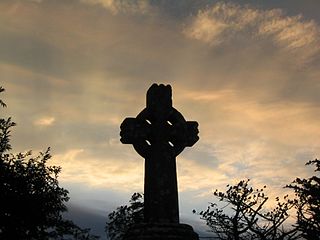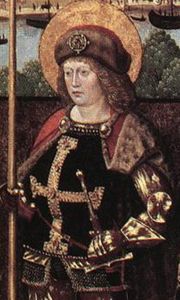
Pope Eleutherius, also known as Eleutherus, was the bishop of Rome from c. 174 to his death. His pontificate is alternatively dated to 171-185 or 177-193. He is venerated as a saint in the Catholic Church.

Celtic Christianity is a form of Christianity that was common, or held to be common, across the Celtic-speaking world during the Early Middle Ages. Some writers have described a distinct Celtic Church uniting the Celtic peoples and distinguishing them from adherents of the Roman Church, while others classify Celtic Christianity as a set of distinctive practices occurring in those areas. Varying scholars reject the former notion, but note that there were certain traditions and practices present in both the Irish and British churches that were not seen in the wider Christian world.

Caerleon is a town and community in Newport, Wales. Situated on the River Usk, it lies 5 miles (8 km) northeast of Newport city centre, and 5.5 miles (9 km) southeast of Cwmbran. Caerleon is of archaeological importance, being the site of a notable Roman legionary fortress, Isca Augusta, and an Iron Age hillfort. Close to the remains of Isca Augusta are the National Roman Legion Museum and the Roman Baths Museum. The town also has strong historical and literary associations: Geoffrey of Monmouth elevated the significance of Caerleon as a major centre of British history in his Historia Regum Britanniae, and Alfred Lord Tennyson wrote Idylls of the King (1859–1885) while staying in Caerleon.

Germanus of Auxerre was a western Roman clergyman who was bishop of Autissiodorum in Late Antique Gaul. He abandoned a career as a high-ranking government official to devote his formidable energy towards the promotion of the church and the protection of his "flock" in dangerous times, personally confronting, for instance, the barbarian king "Goar". In Britain he is best remembered for his journey to combat Pelagianism in or around 429 AD, and the records of this visit provide valuable information on the state of post-Roman British society. He also played an important part in the establishment and promotion of the Cult of Saint Alban. The saint was said to have revealed the story of his martyrdom to Germanus in a dream or holy vision, and Germanus ordered this to be written down for public display. Germanus is venerated as a saint in both the Roman Catholic and Orthodox churches, which commemorate him on 31 July.

Ursula is a legendary Romano-British Christian saint. Her feast day in the pre-1970 Calendarium Romanum Generale is 21 October. There is little information about her and the anonymous group of holy virgins who accompanied and, on an uncertain date, were killed along with her at Cologne. They remain in the Roman Martyrology, although their commemoration does not appear in the simplified General Roman Calendar of the 1970 Missale Romanum.

Amphibalus is a venerated early Christian priest said to have converted Saint Alban to Christianity. He occupied a place in British hagiography almost as revered as Alban himself. According to many hagiographical accounts, including those of Gildas, Bede, Geoffrey of Monmouth, and Matthew of Paris, Amphibalus was a Roman Christian fleeing religious persecution under Emperor Diocletian. Amphibalus was offered shelter by Alban in the Roman city of Verulamium, in modern-day England. Alban was so impressed with the priest's faith and teaching that he began to emulate him in worship, and eventually became a Christian himself. When Roman soldiers came to seize Amphibalus, Alban put on Amphibalus' robes and was punished in his place. According to Matthew Paris, after Alban's martyrdom, the Romans eventually caught and martyred Amphibalus as well.

May 26 - Eastern Orthodox Church calendar - May 28

Saint Cadoc or Cadog was a 5th–6th-century Abbot of Llancarfan, near Cowbridge in Glamorgan, Wales, a monastery famous from the era of the British church as a centre of learning, where Illtud spent the first period of his religious life under Cadoc's tutelage. Cadoc is credited with the establishment of many churches in Cornwall, Brittany, Dyfed and Scotland. He is known as Cattwg Ddoeth, "the Wise", and a large collection of his maxims and moral sayings were included in Volume III of the Myvyrian Archaiology. He is listed in the 2004 edition of the Roman Martyrology under 21 September. His Norman-era "Life" is a hagiography of importance to the case for the historicity of Arthur as one of seven saints' lives that mention Arthur independently of Geoffrey of Monmouth's Historia Regum Britanniae.

June 30 - Eastern Orthodox Church calendar - July 2
St Julians is a community and coterminous electoral district (ward) of the City of Newport, South Wales.

Saint Alban is venerated as the first-recorded British Christian martyr, for which reason he is considered to be the British protomartyr. Along with fellow Saints Julius and Aaron, Alban is one of three named martyrs recorded at an early date from Roman Britain. He is traditionally believed to have been beheaded in Verulamium sometime during the 3rd or 4th century, and his cult has been celebrated there since ancient times.

Gereon of Cologne, who may have been a soldier, was martyred at Cologne by beheading, probably in the early 4th century.

Isca, variously specified as Isca Augusta or Isca Silurum, was the site of a Roman legionary fortress and settlement or vicus, the remains of which lie beneath parts of the present-day suburban town of Caerleon in the north of the city of Newport in South Wales. The site includes Caerleon Amphitheatre and is protected by Cadw.
Representing 43.6% of the Welsh population in 2021, Christianity is the largest religion in Wales. Wales has a strong tradition of nonconformism, particularly Methodism. From 1534 until 1920 the established church was the Church of England, but this was disestablished in Wales in 1920, becoming the still Anglican but self-governing Church in Wales.

Fagan, also known by other names including Fugatius, was a legendary 2nd-century Welsh bishop and saint, said to have been sent by the pope to answer King Lucius's request for baptism and conversion to Christianity. Together with his companion St Deruvian, he was sometimes reckoned as the apostle of Britain.

Deruvian, also known by several other names including Damian, was a possibly legendary 2nd-century bishop and saint, said to have been sent by the pope to answer King Lucius's request for baptism and conversion to Christianity. Together with his companion St Fagan, he was sometimes reckoned as the apostle of Britain. King Lucius's letter may represent earlier traditions but does not appear in surviving sources before the 6th century; the names of the bishops sent to him does not appear in sources older than the early 12th century, when their story was used to support the independence of the bishops of St Davids in Wales and the antiquity of the Glastonbury Abbey in England. The story became widely known following its appearance in Geoffrey of Monmouth's History of the Kings of Britain. This was influential for centuries and its account of SS Fagan and Deruvian was used during the English Reformation to support the claims of both the Catholics and Protestants. Christianity was well-established in Roman Britain by the third century. Some scholars therefore argue the stories preserve a more modest account of the conversion of a Romano-British chieftain, possibly by Roman emissaries by these names.

The Vita Germani is a hagiographic text written by Constantius of Lyon in the 5th century AD. It is one of the first hagiographic texts written in Western Europe, and is an important resource for historians studying the origins of saintly veneration and the "cult of saints." It recounts the life and acts of bishop Germanus of Auxerre, who travelled to Britain c. 429 AD, and is the principal source of details about his life. It is one of the few surviving texts from the 5th century with information about Britain and the Pelagian controversy, and is also one of the first texts to identify and promote the cult of Saint Alban.
The Passio Albani, or Passion of Saint Alban, is medieval hagiographic text about the martyrdom of Saint Alban, the protomartyr of Roman Britain. The author is anonymous, but the work is thought to have been written in the sixth or fifth century. In the latter case, it may actually have been authored or commissioned by Germanus of Auxerre. It currently survives in three different recensions and six separate manuscripts located throughout Europe, and forms the basis for all subsequent retellings of the Saint Alban martyrdom, from Gildas to Bede.

Saint Dyfan is a highly obscure figure who was presumably the namesake of Merthyr Dyfan and therefore an early Christian saint and martyr in southeastern Wales in Roman or Sub-Roman Britain. He is sometimes styled the protomartyr of Wales. The erection of his martyrium was credited to the 6th-century St Teilo. In the 19th century, Edward Williams conflated him with St Deruvian, a figure in the legendary accounts of the baptism of King Lucius of Britain. The discovery of Williams's alterations and forgeries have since discredited this connection. Partially based on this connection, however, the church of Merthyr Dyfan dates his martyrdom to c. 180.

Christianity was present in Roman Britain from at least the third century until the end of the Roman imperial administration in the early fifth century, and continued in western Britain.

















